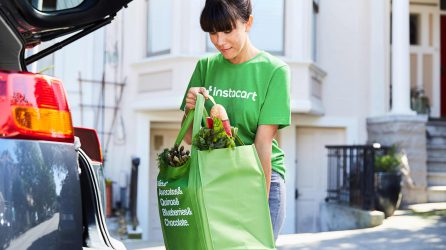The Marketer's Guide to Banner Display Advertising in Online Grocery

Presented by:
Josi Mathar — 2020
If you’re a brand marketer or eCommerce manager and you’re not yet thinking about banner display advertising for grocery retail, your competitors are going to have a massive advantage when it comes to winning on the online shelf. Let's show how you can stop that from happening.
In this article we’ll discuss:
- What banner display advertising is, and why you should familiarise yourself with it as soon as possible.
- The benefits of banner display advertising for online grocery.
- Current trends within banner display advertising, and how your competitors are likely using their banner display budgets.
- The “new normal” of consumer behaviour in relation to eRetail Media.
- A step-by-step guide to banner display advertising considerations.
- How you can get ahead of the curve by tracking and monitoring your banner display ads using digital shelf analytics.
As shoppers move online, CPGs are shifting budgets to display advertising.
What Is Banner Display Advertising in Retail?
Banner display advertising — also sometimes called “banner advertising” or "eRetail Media" — is a form of online paid advertising that uses graphical (image, video and text) ads on relevant third-party websites or retailer apps to obtain clicks, views and sales from interested shoppers. This form of advertising is also a great way to keep your brand at the forefront of a shopper’s mind through visual recognition at multiple points on their purchasing journey.
Why Is Banner Display Advertising Important?
According to the latest report by the IAB, internet advertising continues to be by far the most dominant player across all media channels, with a massive 15.9% growth between 2018 and 2019 alone (with data taken from January to December of both years).
Any brand that doesn’t tap into such a massive opportunity — not only from the point of view of actual sales but also from a brand visibility perspective — is effectively handing their competitors an advantage in the online space.
Thankfully, gaining familiarity with banner display advertising, and especially understanding the return of investment from it, doesn’t need to be a daunting task.
The Benefits of Banner Display Advertising for Online Grocery
There are many benefits associated with using banner display advertising for online grocery. In this section, we’ll list them, and we’ll use some concrete examples to highlight their massive potential return on investment (ROI) — from both brand awareness and revenue perspectives.
- Display Ads are Visually Appealing:
We’ll get into the different types of display ads later in the post, but one of the biggest benefits of this form of digital marketing is that there are multiple different ways of presenting your brand to your target audience. Having the flexibility to work with creative assets as well as text opens up the potential for better communication of your brand values and voice, even “at a glance”. - Increase Brand Awareness:
Brands that use banner display ads can increase their brand awareness and boost organic and cross-channel performance. This isn’t just critical to the “see and buy” customer experience, but also for the types of customers that might “see and come back later” or even “see and go to buy in-store”. - Custom Targeting:
Gone are the days when an online ad meant clicking a few buttons and crossing your fingers in the hopes that the right person would see it now and again. The targeting options for banner display advertising are varied, and they continue to get more and more granular. Targeting settings include — but are not limited to — age and gender demographics and/or to certain affinity groups (topical interests). In grocery advertising, demographic targeting may be available however typically it will be offered as placements enabling brands to place ads and target key category pages or elements of the shopper journey. - Track Your ROI:
No one wants to pour money and resources into a certain type of advertising only to be met with woolly numbers that can’t be traced back to real, concrete results. With the e.fundamentals banner display tracking software, businesses can efficiently see when and where their banner ads are live and also track retailer compliance on link positions and frequency. In addition, the e.fundamentals service shows banner ad visibility by category so you can understand who is spending money in your category and therefore paying for visibility. - Display Ads Don’t Break the Bank:
When it comes to cost per click (CPC), this type of digital marketing is typically less expensive than traditional pay-per-click (PPC) advertising. In fact — according to a study performed by WebFX — the average cost of an advertisement on Google Ads (AdWords) is $1-$2 per click, whereas the average CPC of an ad on the Display Network is under $1. Many online retailers will offer a range of pricing options that cater for position and location, so you can spend big on the homepage or be more tactical by opting to sponsor category or featured pages only. For brands looking to capture shoppers' attention with new product launches or special offers, Cost Per Impressions (CPM) options also offer favourable display ad opportunities.
Reaching shoppers when they're most receptive is a great advantage of using targeted display banner ads on online retailers sites.
Current Trends in Banner Display Advertising
While we have seen a general “up and to the right'' trend across many aspects of digital marketing, when it comes to the online grocery space, current trends suggest that an unprecedented amount is being spent on eRetail Media as an alternative to in-store activations that are increasingly difficult to execute as a result of the pandemic.
In our latest podcast episode Get more from your eRetail Media spend our guest Ben Taylor, Head of Omnichannel Commerce at Publicis Commerce comments,
“For grocery it really is about search and favourites. You can only secure those if you have a really competitive price promotion. Obviously, retailers determine prices, but they're effectively the online equivalent of the gondola end and so are the two pieces of activity you really want to secure if you want to get a campaign right.”
At present, Amazon set the benchmark for banner display advertising and performance measuring. CPGs favour Amazon's Sponsored Products format as it allows even novices to create and measure digital ads that boost the discoverability of their products they sell on Amazon. Brands looking to succeed beyond Amazon and are operating in the US, Walmart's advertising marketplace is a serious competitor to "The Everything Store".
Walmart currently offers sellers 4 different types of banner display ads and sponsored product opportunities that increase visibility for shoppers at the point of browsing. With its placement offerings come advanced performance measurement capabilities that allow CPGs to better understand their ROI. Capabilities only few retailers can currently match which makes software like e.fundamentals' banner display tracking almost indispensable for CPGs investing in eRetail Media.
In the UK, Sainsbury's has started partnering with CitrusAd helping to streamline their media sales and ad serving. CPGs working with the British retailer can request a great degree of personalisation and targeting as well as real-time performance tracking.
Competition in the Banner Display Advertising Space
This increase in spend indicates that competition is becoming increasingly fierce in the online grocery space. The IAB report concludes: “As competition for attention increases, advertisers are dependent upon creativity for cutting through the clutter combined with relevance for ROI.”
As we noted above, display advertising is perfect for targeted visibility, and its different available formats enable brands to discover which style works best — not only for them as a brand, but (where relevant) for every single item they’re looking to promote.
This granularity acts as a double-edged sword because it has the potential to overwhelm and create burnout for many brands, also as retailers still largely differ in their offering and data transparency, but the use of tools such as the e.fundamentals display banner tracking functionality make understanding banner activity simple time efficient and impactful. By knowing what your competitors are doing across the category you can start to understand spend in category, promotional strategy and combine execution to excite, engage and capture shoppers.
What does the “New Normal” look like for Consumer Behaviour?
COVID-19’s impact on digital marketing for the CPG space began in early March 2020. Although advertising spend continued to grow year on year (up 12%), this had decreased from 17.2% when compared to growth in previous years. However, as consumers get more and more accustomed to purchasing groceries online, we have seen a massive increase in overall sales. This is largely thanks to the amount of older consumers that are now almost being forced to shop online.
According to a report from Mintel, this “new normal” of online shopping has resulted in a boom in sales — up by over a consistent 33% from last year — making opportunities such as display advertising all the more lucrative for brands that want to make sure they’re getting the lion’s share of the sales increase. In the US, some retailers have seen significant online sales growth of upwards of 280%.
Brands across e-retailers are vying for shoppers attention which is why actionable insights for the digital shelf are becoming essential to monitor spend and ROI.

A Step-By-Step Guide to Display Banner Advertising Considerations
With the above in mind, it’s time to go through our step-by-step guide to considerations you must make when strategising the best way to get started with (or improve your existing) display advertising.
How to Determine Your Display Advertising Needs
Before diving into setting up and tracking your display advertising performance, it’s important to figure out what your needs are, both on a brand and product level. Here is a list of considerations you’ll need to work through to determine your display ad priorities.
- Who Do You Need to Reach?
This will likely change based on the specific product you’re advertising. Having a solid view of your consumer will result in less budget churn and faster ad optimisation opportunities. It will also influence what type of display advertising will work best to obtain clicks and sales. - What’s Your Target Cost per Acquisition (CPA)?
If you don’t know what sort of return on investment you’re looking for, you may end up spending more than necessary. This could result in a strategy that doesn’t make much sense medium to long-term, and it could even make you complacent when it comes to ensuring that your display advertising is working as hard as you do. - Do You Have Any Budgetary Constraints?
Unfortunately, we don’t live in a world where digital marketing spend is infinite. Display advertising is incredibly cost-effective, but that isn’t to say that understanding your budget won’t go a long way in prioritising campaign output, allowing you to focus on advertising strategy and tactics. - Which Items (Or Brand) Do You Need to Promote? Again, this will impact the type of display ads you go with and, most likely, the way your campaigns are structured from the ground-up. You may be deciding that banner display advertising is the short term play you need to promote a new NPD or try and increase category perception of a SKU range that isn't ranking well organically in the retailers search.
CPGs have different needs to fulfil when identifying display banner ads formats.
Types of Display Ads
When it comes to advertising, your products won’t be “one size fits all”. You need a marketing approach that accounts for differences in demographic, geography, budget and design. Thankfully, display ads are perfect for such an approach. Below, we’ll go through each type of display ad available for your campaign.
- Banner Ads: These are the original “banner image in the margins” type of ads. They’re often called “static” ads because they don’t change when someone interacts with them.
- Video Ads: As video becomes more and more important in the online marketing space, having the opportunity to place this sort of ad where it will be seen by specifically targeted demographics can be a powerful tool.
- Interstitial: Appearing before a user reaches the web page or app of their choice, interstitial ads are arguably the most “push marketing” approach to display advertising. However, they can be incredibly powerful when used correctly — especially for impulse purchases.
- Rich Media: This covers a few different subsets of display ads, including interactive, animated, expandable and lightbox ads. These all serve to get the visitor engaging with your product/brand before taking further action to move down the sales funnel.
- Carousel Ads: It’s often the case that you’ll have more than one product to show potential customers. These sorts of ads are able to combine multiple images (or videos) in a single ad, which can be scrolled through by the customer. A massive benefit of this sort of ad for the grocery space comes from multi-product marketing, effectively enabling your ad to improve visibility across multiple items.
- Programmatic Ads: This type of advertising refers to ad buyers relying on software to purchase eRetail Media. The Display Trading Council as quoted by the Marketing Week explains programmatic as "the use of automation in buying and selling of media". It's an efficient way of using banner ads, it should not be confused with real-time bidding however which is an auction-based model compared to the full depth of automation that advertisers employ with programmatic banner display ads.
Different types of advertising enable sales and marketing to target specific shopper profiles.
When to Start using eRetail Media?
The best time to start working on preparing and implementing your display advertising is straight away — there’s no reason not to. As Ben Taylor puts it in our podcast,
“[eRetail Media] sounds like it's complicated but is in fact really simple as most media is. Basically, all it is is space that turns up where you can supply a message to change people's purchase behaviour.”
Display advertising isn’t a “set and forget” exercise. As with all the best marketing opportunities, it requires careful planning and further optimisation to make the ads run as efficiently as possible. While a certain amount of patience is required for data-gathering, brands need to keep an eye on what their ads are doing at every step of the way or risk unnecessary budget churn.
Some great examples of where you may want to start with display ads in online retail:
- Category or Taxonomy Pages: If you’re not yet ranking in search, you can grab the top spot with a paid placement ad.
- Below the Checkout Button: Many retailers offer small ad placements below key calls to action. These are sure to get your shoppers’ attention and drive clicks for impulse purchases. Online, any item can be ‘next to the till’, not just chewing gum and SIM cards!
- Cross Sell: This can either be a complementary offer at check out (recall the sensitive toothpaste / ice cream offer pairing) or within category pages offer your product as a suitable pair.
- Favourites: Offers on one’s favourites enables brands to ensure shopper retention. Thus, once a brand has been ‘favoured’ it can be hard for a category competitor to gain traction. Targeted display ads in favourites can be a way of suggesting an attractive alternative.
- Themed and Event Pages: Temporary category and curated product pages are great opportunities for brands to maximise visibility and conversion with online shoppers, who are there to purchase for specific occasions.
- Deal or Offer Pages - Being part of a retailer offer period can usually bank you additional exposure and ad placements, ASDA rollback products, for example, are featured heavily in many key locations in the category and out.
- eCoupons and Sampling: e-Coupons offer shoppers a discount code they can redeem often at the check-out stage. It helps boost retention as part of loyalty schemes or encourages new shoppers to repeat purchases. The same can be achieved with sampling. This method can be valuable with NPDs.
- Collaboration ads: Some retailers may support placing banner display advertising on media outlets like TheGuardian.com or Supermarketnews.com to drive traffic to their products on retailer sites.
With the right digital shelf tracking and measuring tool, brands can ensure brand execution across their eRetailers.

A digital shelf analytics platform that helps you spot growth opportunities online can help CPGs scale digital growth fast and sustainably.
How to Track and Monitor Your Banner Display Using Digital Shelf Analytics
Monitoring an ad campaign is the key to its success. That’s why e.fundamentals is proud to be rolling out a key-turning display banner tracking functionality as an added-on part of its service offering.
This banner display tracking functionality allows you to see a category view and share of ad %. In essence, you will be able to work out the share of display spend and how much competitors are investing in online advertising, giving you vital insights to take forward both tactically and strategically.
In summary, the feature allows you to:
- Track your own banner display coverage across retailers
- View competitor banner display activity in your category
- Access visibility metrics on your banner performance
- Understand where and when your banners are being shown by retailers and which formats (carousel or fixed banner e.g.)
Linking the insights found through e.fundamentals' banner display ad tracking feature to search visibility is both efficient and effective. The ability to see “out of stock” and promotional tags allows brands to understand the ROI generated from undertaking banner display ads on a retailer’s site. Having access to this level of banner display ads service, finally allows sales and marketing teams to optimise their digital advertising spend, category promotion planning and brand execution.
Are you ready to take the guesswork out of banner display advertising?
Never miss a growth opportunity on the digital shelf. Ensure you can track your digital performance and ad spend with accurate, fully visualised category data insights. Outsmart the competition, book a demo of our digital shelf analytics software today.
All the digital Shelf Analytics You Need to Succeed at Speed & Scale
See why world leading brands choose e.fundamentals for actionable digital shelf insights
Request A demoLatest Resources

CommerceIQ Launches Global Retail Ecommerce Management Platform Combining Sales, Supply Chain, Retail Media, and Digital Shelf with e.fundamentals Acquisition
Ecommerce platform enables consumer brands to grow market share profitably in today’s inflationary and supply-constrained environment through intelligent automation, supporting over 450 omnichannel retailers in 41 countries.

e.fundamentals becomes a CommerceIQ company
e.fundamentals has been acquired by CommerceIQ, the leading Retail Ecommerce Management Platform, headquartered in Palo Alto, California. Consumer brands can now harness one global software platform to power profitable market share growth across all major retailers.

5 strategic pricing opportunities CPGs should focus on now
As tensions run high between retailers and suppliers, CPGs need to be smarter than ever about strategic pricing. Here’s how to use digital shelf analytics to hold your own in tough negotiations.

What the smartest CPGs get right about selling on Instacart
This post has been updated and was originally published March 30, 2021. It's time CPGs get ready to win on Instacart. So read and learn: What's all the hype around…

5 optimization tactics to grow digital shelf sales
This post has been updated and was originally published May 14, 2020. Consumer goods companies (CPG) continue to grapple with enormous shifts to the industry as the eCommerce boom continues…

5 tactics to grow online sales for category managers
Category management has changed. We've highlighted the 5 tactics to help you scale your growth on the digital shelf at speed.
View Our Most Popular resources to help you learn and win on the digital shelf.

The Ultimate Guide to Content Management on the Digital Shelf

The Digital Shelf Cast - Listen to our latest episode





